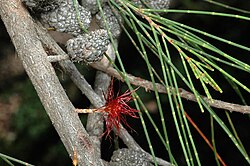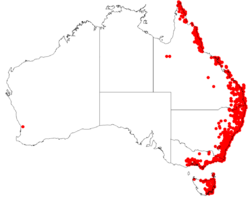Biology:Allocasuarina littoralis
| Allocasuarina littoralis | |
|---|---|

| |
| Female cones | |
| Scientific classification | |
| Kingdom: | Plantae |
| Clade: | Tracheophytes |
| Clade: | Angiosperms |
| Clade: | Eudicots |
| Clade: | Rosids |
| Order: | Fagales |
| Family: | Casuarinaceae |
| Genus: | Allocasuarina |
| Species: | A. littoralis
|
| Binomial name | |
| Allocasuarina littoralis (Salisb.) L.A.S.Johnson[2]
| |

| |
| Occurrence data from AVH | |
| Synonyms[2] | |
|
List
| |
Allocasuarina littoralis, commonly known as black she-oak,[3] is a species of flowering plant in the family Casuarinaceae and is endemic to eastern Australia. It is dioecious, or less commonly a monoecious tree or shrub, that has its leaves reduced to scales, usually in whorls of six to eight, the mature fruiting cones 10–30 mm (0.39–1.18 in) long containing winged seeds (samaras) 4.0–10 mm (0.16–0.39 in) long.
Description
Allocasuarina littoralis is a dioecious, or less commonly a monoecious tree or shrub, that typically grows to a height of 5–15 m (16–49 ft). Its branchlets are usually up to 200 mm (7.9 in) long, rarely to 350 mm (14 in), the leaves reduced to scale-like teeth 0.3–0.9 mm (0.012–0.035 in) long, arranged in whorls of usually six to eight around the branchlets. The sections of branchlet between the leaf whorls (the "articles") are 4–10 mm (0.16–0.39 in) long and 0.4–1.0 mm (0.016–0.039 in) wide. Male flowers are arranged in spikes 5–50 mm (0.20–1.97 in) long, in whorls of six to twelve per centimetre (per 0.39 in.), the anthers 0.4–0.8 mm (0.016–0.031 in) long. Female cones are on a peduncle 4–23 mm (0.16–0.91 in) long, the mature cones cylindrical, 10–30 mm (0.39–1.18 in) long and 8–21 mm (0.31–0.83 in) in diameter containing dark brown to black samaras 4.0–10 mm (0.16–0.39 in) long.[3][4][5]
Taxonomy
Black she-oak was first formally described in 1796 by Richard Anthony Salisbury, who gave it the name Casuarina littoralis in his Prodromus stirpium in horto ad Chapel Allerton vigentium from specimens collected at Botany Bay by Joseph Banks.[6][7] It was reclassified in 1982 as Allocasuarina littoralis by Lawrie Johnson in the Journal of the Adelaide Botanic Gardens.[8] The specific epithet (littoralis) means "pertaining to the sea-shore".[9]
Distribution and habitat
Allocasuarina littoralis mainly grows on sand in woodland in near-coastal areas, but sometimes in heavy clay or among rocks, sometimes on nearby tablelands, and occasionally in tall heath. It occurs from Cape York in far north Queensland, through New South Wales, the Australian Capital Territory and Victoria, to the east coast of Tasmania and as far south as Hobart.[3][4][5]
References
- ↑ IUCN SSC Global Tree Specialist Group.; Botanic Gardens Conservation International (BGCI). (2020). "Allocasuarina littoralis". IUCN Red List of Threatened Species 2020: e.T177363529A177369822. doi:10.2305/IUCN.UK.2020-3.RLTS.T177363529A177369822.en. https://www.iucnredlist.org/species/177363529/177369822. Retrieved 2 July 2022.
- ↑ Jump up to: 2.0 2.1 "Allocasuarina littoralis". https://biodiversity.org.au/nsl/services/apc-format/display/82294. Retrieved 15 June 2023.
- ↑ Jump up to: 3.0 3.1 3.2 Wilson, Karen L.; Johnson, Lawrence A.S.. "Allocasuarina littoralis". Royal Botanic Garden Sydney. https://plantnet.rbgsyd.nsw.gov.au/cgi-bin/NSWfl.pl?page=nswfl&lvl=sp&name=Allocasuarina~littoralis.
- ↑ Jump up to: 4.0 4.1 "Allocasuarina littoralis". Australian Biological Resources Study, Department of Agriculture, Water and the Environment: Canberra. https://profiles.ala.org.au/opus/foa/profile/Allocasuarina%20littoralis.
- ↑ Jump up to: 5.0 5.1 Entwisle, Timothy J.; Stajsic, Val. "Allocasuarina littoralis". Royal Botanic Gardens Victoria. https://vicflora.rbg.vic.gov.au/flora/taxon/ffb1666e-3e9a-4d25-9b99-fc5a7edfaf69.
- ↑ "Casuarina littoralis". APNI. https://id.biodiversity.org.au/instance/apni/458534. Retrieved 15 June 2023.
- ↑ Salisbury, Richard A. (1796). Prodromus stirpium in horto ad Chapel Allerton vigentium. London. p. 2. https://www.biodiversitylibrary.org/item/9522#page/9/mode/1up. Retrieved 15 June 2023.
- ↑ "Allocasuarina littoralis". APNI. https://id.biodiversity.org.au/instance/apni/499349.
- ↑ William T. Stearn (1992). Botanical Latin. History, grammar, syntax, terminology and vocabulary (4th ed.). Portland, Oregon: Timber Press. p. 442.
Wikidata ☰ Q2838503 entry
 |




